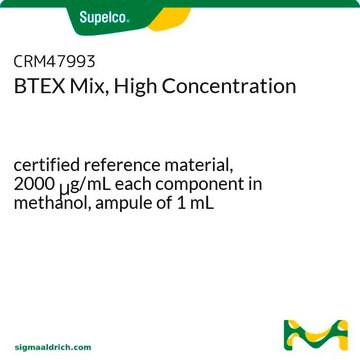342270
Carbon disulfide
ReagentPlus®, low benzene, ≥99.9%
About This Item
Recommended Products
vapor density
2.67 (vs air)
Quality Level
vapor pressure
5.83 psi
product line
ReagentPlus®
Assay
≥99.9%
form
liquid
autoignition temp.
212 °F
purified by
glass distillation
expl. lim.
50 %
impurities
<0.05% water
<1 ppm Benzene
evapn. residue
<0.0003%
refractive index
n20/D 1.627 (lit.)
bp
46 °C (lit.)
mp
−112-−111 °C (lit.)
density
1.266 g/mL at 25 °C (lit.)
SMILES string
S=C=S
InChI
1S/CS2/c2-1-3
InChI key
QGJOPFRUJISHPQ-UHFFFAOYSA-N
Looking for similar products? Visit Product Comparison Guide
Related Categories
Application
- To synthesize hydroxynaphthyl ketones via Friedel-Crafts acylation and demethylation.
- In the regioselective bromination of binaphthols.
Legal Information
Signal Word
Danger
Hazard Statements
Precautionary Statements
Hazard Classifications
Acute Tox. 4 Inhalation - Eye Irrit. 2 - Flam. Liq. 2 - Repr. 2 - Skin Irrit. 2 - STOT RE 1
Target Organs
Peripheral nervous system,Central nervous system,Cardio-vascular system,Eyes
Storage Class Code
3 - Flammable liquids
WGK
WGK 2
Flash Point(F)
-22.0 °F - closed cup
Flash Point(C)
-30 °C - closed cup
Certificates of Analysis (COA)
Search for Certificates of Analysis (COA) by entering the products Lot/Batch Number. Lot and Batch Numbers can be found on a product’s label following the words ‘Lot’ or ‘Batch’.
Already Own This Product?
Find documentation for the products that you have recently purchased in the Document Library.
Our team of scientists has experience in all areas of research including Life Science, Material Science, Chemical Synthesis, Chromatography, Analytical and many others.
Contact Technical Service








